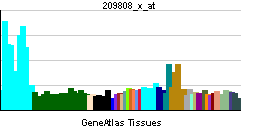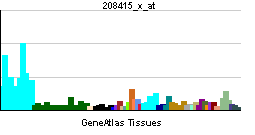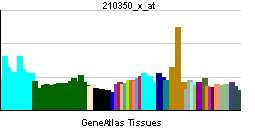ING1
| Inhibitor of growth family, member 1 | |||||||||||
|---|---|---|---|---|---|---|---|---|---|---|---|
| Identifiers | |||||||||||
| Symbols | ING1 ; p24ING1c; p33; p33ING1; p33ING1b; p47; p47ING1a | ||||||||||
| External IDs | Template:OMIM5 Template:MGI HomoloGene: 40119 | ||||||||||
| |||||||||||
| RNA expression pattern | |||||||||||
 | |||||||||||
 | |||||||||||
 | |||||||||||
| More reference expression data | |||||||||||
| Orthologs | |||||||||||
| Template:GNF Ortholog box | |||||||||||
| Species | Human | Mouse | |||||||||
| Entrez | n/a | n/a | |||||||||
| Ensembl | n/a | n/a | |||||||||
| UniProt | n/a | n/a | |||||||||
| RefSeq (mRNA) | n/a | n/a | |||||||||
| RefSeq (protein) | n/a | n/a | |||||||||
| Location (UCSC) | n/a | n/a | |||||||||
| PubMed search | n/a | n/a | |||||||||
Inhibitor of growth family, member 1, also known as ING1, is a human gene.[1]
This gene encodes a tumor suppressor protein that can induce cell growth arrest and apoptosis. The encoded protein is a nuclear protein that physically interacts with the tumor suppressor protein TP53 and is a component of the p53 signaling pathway. Reduced expression and rearrangement of this gene have been detected in various cancers. Multiple alternatively spliced transcript variants encoding distinct isoforms have been reported.[1]
References
Further reading
- Campos EI, Chin MY, Kuo WH, Li G (2004). "Biological functions of the ING family tumor suppressors". Cell. Mol. Life Sci. 61 (19–20): 2597–613. doi:10.1007/s00018-004-4199-4. PMID 15526165.
- Garkavtsev I, Kazarov A, Gudkov A, Riabowol K (1997). "Suppression of the novel growth inhibitor p33ING1 promotes neoplastic transformation". Nat. Genet. 14 (4): 415–20. doi:10.1038/ng1296-415. PMID 8944021.
- Helbing CC, Veillette C, Riabowol K; et al. (1997). "A novel candidate tumor suppressor, ING1, is involved in the regulation of apoptosis". Cancer Res. 57 (7): 1255–8. PMID 9102209.
- Garkavtsev I, Riabowol K (1997). "Extension of the replicative life span of human diploid fibroblasts by inhibition of the p33ING1 candidate tumor suppressor". Mol. Cell. Biol. 17 (4): 2014–9. PMID 9121449.
- Garkavtsev I, Demetrick D, Riabowol K (1997). "Cellular localization and chromosome mapping of a novel candidate tumor suppressor gene (ING1)". Cytogenet. Cell Genet. 76 (3–4): 176–8. PMID 9186514.
- Zeremski M, Horrigan SK, Grigorian IA; et al. (1997). "Localization of the candidate tumor suppressor gene ING1 to human chromosome 13q34". Somat. Cell Mol. Genet. 23 (3): 233–6. PMID 9330636.
- Garkavtsev I, Grigorian IA, Ossovskaya VS; et al. (1998). "The candidate tumour suppressor p33ING1 cooperates with p53 in cell growth control". Nature. 391 (6664): 295–8. doi:10.1038/34675. PMID 9440695.
- Shinoura N, Muramatsu Y, Nishimura M; et al. (1999). "Adenovirus-mediated transfer of p33ING1 with p53 drastically augments apoptosis in gliomas". Cancer Res. 59 (21): 5521–8. PMID 10554029.
- Jäger D, Stockert E, Scanlan MJ; et al. (2000). "Cancer-testis antigens and ING1 tumor suppressor gene product are breast cancer antigens: characterization of tissue-specific ING1 transcripts and a homologue gene". Cancer Res. 59 (24): 6197–204. PMID 10626813.
- Sanchez-Cespedes M, Okami K, Cairns P, Sidransky D (2000). "Molecular analysis of the candidate tumor suppressor gene ING1 in human head and neck tumors with 13q deletions". Genes Chromosomes Cancer. 27 (3): 319–22. PMID 10679922.
- Tokunaga E, Maehara Y, Oki E; et al. (2000). "Diminished expression of ING1 mRNA and the correlation with p53 expression in breast cancers". Cancer Lett. 152 (1): 15–22. PMID 10754201.
- Baranova AV, Ivanov DV, Makeeva NV; et al. (2000). "[Genomic organization of the suppressor gene for tumor growth ING1]". Mol. Biol. (Mosk.). 34 (2): 263–9. PMID 10779953.
- Saito A, Furukawa T, Fukushige S; et al. (2000). "p24/ING1-ALT1 and p47/ING1-ALT2, distinct alternative transcripts of p33/ING1". J. Hum. Genet. 45 (3): 177–81. PMID 10807544.
- Gunduz M, Ouchida M, Fukushima K; et al. (2000). "Genomic structure of the human ING1 gene and tumor-specific mutations detected in head and neck squamous cell carcinomas". Cancer Res. 60 (12): 3143–6. PMID 10866301.
- Skowyra D, Zeremski M, Neznanov N; et al. (2001). "Differential association of products of alternative transcripts of the candidate tumor suppressor ING1 with the mSin3/HDAC1 transcriptional corepressor complex". J. Biol. Chem. 276 (12): 8734–9. doi:10.1074/jbc.M007664200. PMID 11118440.
- Nagashima M, Shiseki M, Miura K; et al. (2001). "DNA damage-inducible gene p33ING2 negatively regulates cell proliferation through acetylation of p53". Proc. Natl. Acad. Sci. U.S.A. 98 (17): 9671–6. doi:10.1073/pnas.161151798. PMID 11481424.
- Scott M, Bonnefin P, Vieyra D; et al. (2001). "UV-induced binding of ING1 to PCNA regulates the induction of apoptosis". J. Cell. Sci. 114 (Pt 19): 3455–62. PMID 11682605.
- Kuzmichev A, Zhang Y, Erdjument-Bromage H; et al. (2002). "Role of the Sin3-histone deacetylase complex in growth regulation by the candidate tumor suppressor p33(ING1)". Mol. Cell. Biol. 22 (3): 835–48. PMID 11784859.
- Nouman GS, Angus B, Lunec J; et al. (2002). "Comparative assessment expression of the inhibitor of growth 1 gene (ING1) in normal and neoplastic tissues". Hybrid. Hybridomics. 21 (1): 1–10. doi:10.1089/15368590252917584. PMID 11991811.
- Bromidge T, Lynas C (2002). "Relative levels of alternative transcripts of the ING1 gene and lack of mutations of p33/ING1 in haematological malignancies". Leuk. Res. 26 (7): 631–5. PMID 12008079.
External links
- ING1+protein,+human at the US National Library of Medicine Medical Subject Headings (MeSH)
| This protein-related article is a stub. You can help Wikipedia by expanding it. |
This article incorporates text from the United States National Library of Medicine, which is in the public domain.